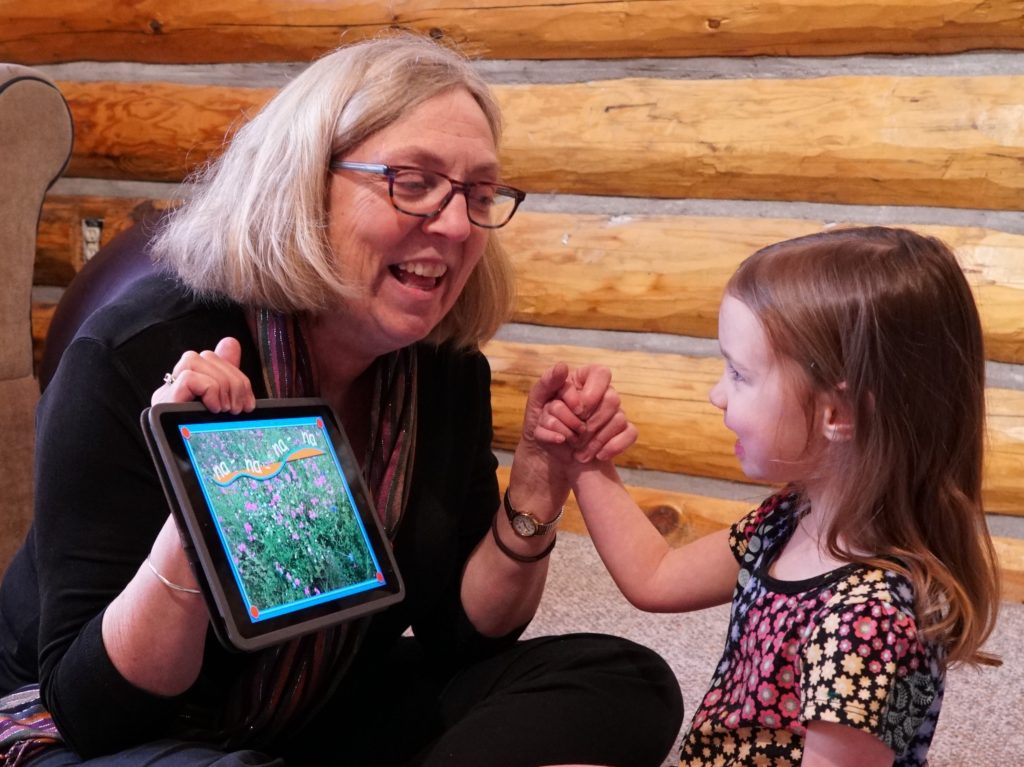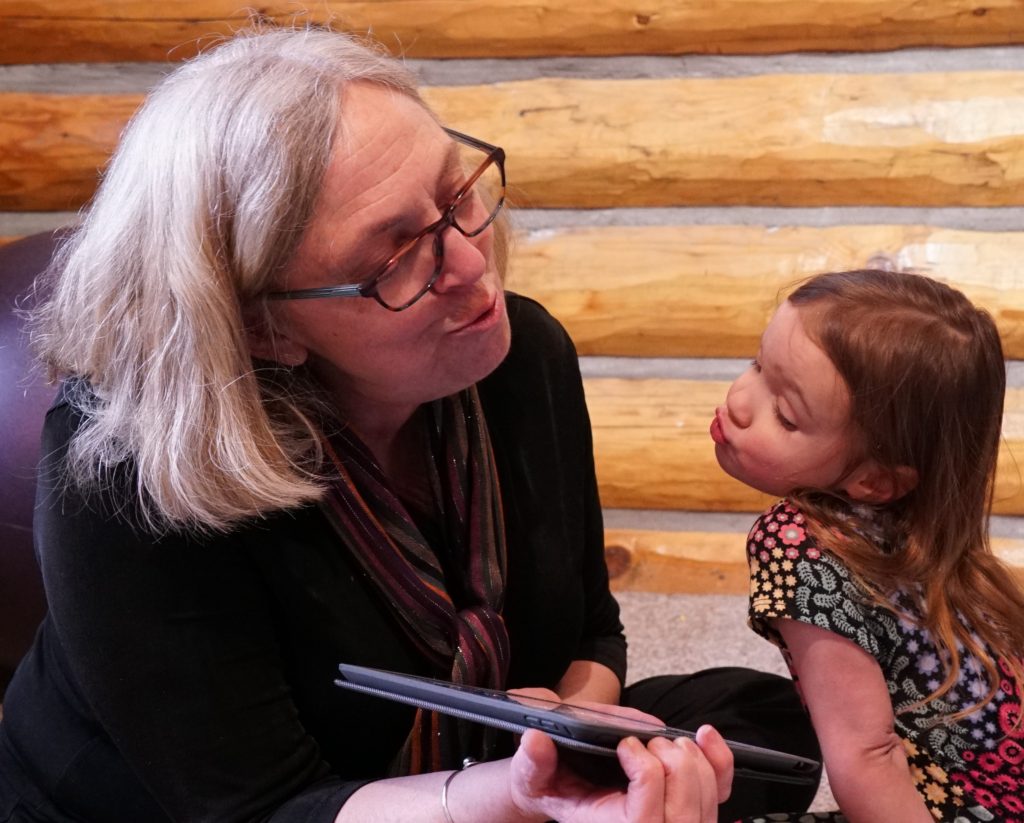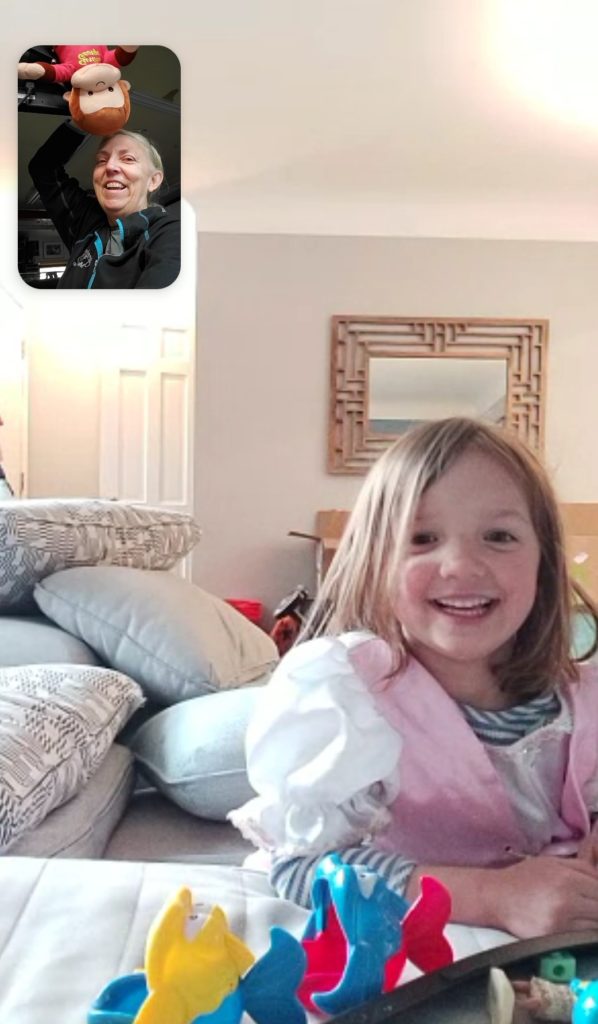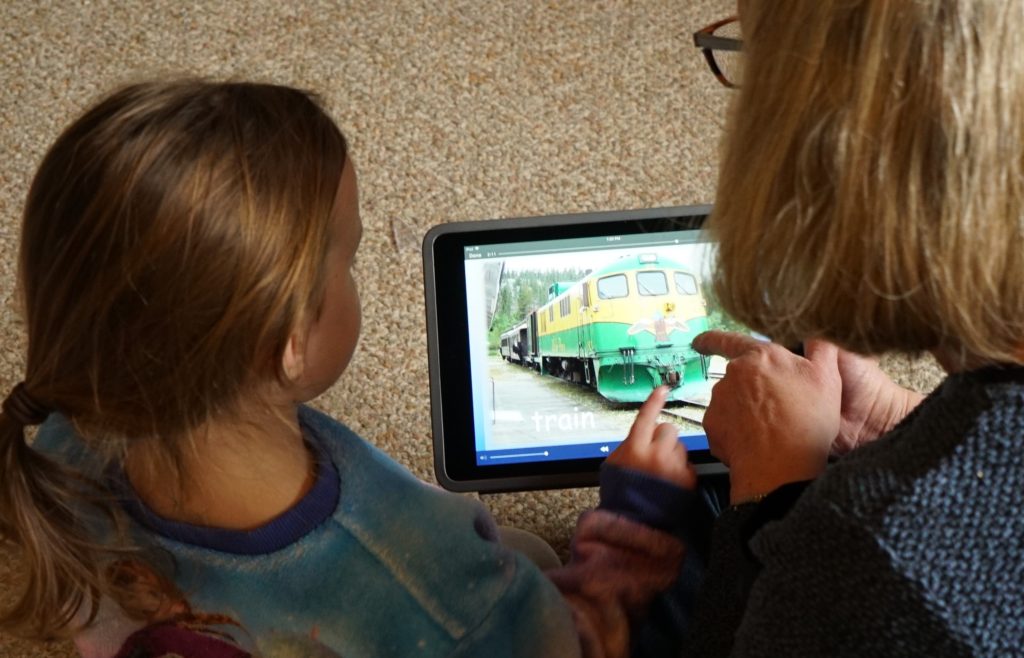By Willow Sauermilch, M.A. CCC/SLP

At a convention many years ago, I met Willow Sauermilch, a speech-language pathologist who had a particular interest in technology use with children. Because both of us know that technology can be an incredible learning tool and one that can have negative effects , we have stayed in touch over the years. Willow has since taken her interest in technology use to a whole new level.
Here is her bio:
Willow Sauermilch, M.A. CCC/SLP has worked in a variety of early intervention and school-based settings for the past 16 years. Not only is she a speech-language pathologist but she holds a second master’s degree in Mass Communication. She shares technology information for parents and educators on Instagram (@app_along) and her blog (www.appalong.com) Willow is currently a doctoral candidate in the College of Media and Communication at Texas Tech University where she focuses on helping parents, educators, and SLPs facilitate meaningful and language-rich interactions around technology use in home and therapeutic environments.
Because of her
expertise in this area of screen time and technology use with children, I asked
her to offer her insight and suggestions. Technology in and of itself is not
bad. Let’s learn how we can take this tool and use it to benefit our children.
Thank you, Willow, for your incredible article.
Addressing Screen Time Concerns During the COVID-19 Pandemic
More than ever, screen time is now an important part of our lives (whether we want it to be or not). Our televisions, computers, tablets, and smartphones provide connections that are more critical than ever as we access news and health information, work and learn from home, participate in therapy, and reach out to family and friends. At the end of the day, technology also offers us the opportunity to enjoy something funny, lift our spirits, and remember when things felt normal.
But what about all those concerns about screen time? A global pandemic doesn’t just erase the negative effects of technology use. The research on the negative (and positive) effects of children’s technology use has not changed. What has changed, however, is the context in which we make decisions about technology use. Luckily, we have decades of media effects research to help us navigate our increasingly digital lives.
First and foremost, YOU matter! Life is crazy right now. We are all doing the best that we can as we adjust to this “new normal.” You provide kids the love, comfort, and security that they need to feel safe with so much changing all around them – big and small. Children learn from watching and interacting with you. Surveys have shown that kids enjoy using technology with someone else, such as a sibling, parent, or caregivers. The key to good communication (and technology use) is YOU, found in the smiles, the conversations, the giggles, and time that you spend playing and interacting together.

Media Content Matters
Not all screen time is beneficial, which is why media content matters. Research shows that children learn the most, especially language and social skills, when watching age-appropriate, educational and prosocial content. Examples include, but aren’t limited to Sesame Street, Mister Rogers’ Neighborhood, Daniel Tiger’s Neighborhood, Super Why, and other PBS programming. It is important to consider not only the program or app itself but what the characters are doing. For instance, characters might talk about the things that they see, helping kids make connections between the spoken words and the pictures they see on the screen. Some shows are more interactive with characters asking questions, pausing to allow viewers at home time to answer. Programs may also introduce new words and concepts, explaining what they mean and then using the word in different ways throughout the show. Quality educational programming provides content that can reinforce what children learn in school and speech therapy.
The Way You Use Media Matters
Parents and family members play important roles in minimizing negative media effects while maximizing positive ones. Coviewing is simply the act of parents simultaneously viewing media content with children in the same room (though benefits are also seen with siblings, grandparents, caregivers, and teachers). Coviewing could be two siblings sitting together on the couch watching their favorite tv show or a parent making dinner while monitoring what their child is playing with on a tablet nearby. Even if you are not actively watching with your child, your presence signals to children that you approve the content and it is worthy of their attention. Research shows that children learn more from the program when coviewing than when they watch alone. Children who coview also pay more attention to the media program and view the content more positively than children who watch alone. For these reasons, the American Academy of Pediatrics recommends that parents and caregivers coview media with children.

We know that our words matter. When parents talk about media content before, during, and/or after media viewing, parents influence how children perceive, evaluate, and learn from media experiences. Research indicates that by talking about the media content during coviewing, adults have the power to reduce the harm media viewing has on child development, including language. Talking about media content also helps children connect what they see and hear on screens to their own daily lives, something that is critically important in times of public crisis.
What about screen time that involves live, interactive video like FaceTime, Skype, and Zoom? Talking with friends and family or participating in online therapy sessions is very different than screen time spent watching tv programs or playing apps. Video chats are unique as they provide children with individualized experiences, in which communication partners (both those on screen and sitting next to them) offer social interactions specific to the child. Unlike commercial programming, video partners call the child by name, respond to their comments, and answer their questions, much like they do in real life. Not only does the American Academy of Pediatrics exclude live video chatting from their screen time recommendations, but a growing body of research indicates that young children learn vocabulary and communication-related skills via these screen-based interactions.

Screen Time Recommendations and Resources
The following research-based strategies offer guidance as we navigate increased screen time use.
- As our lives require us to spend more time online, we need to be mindful of our own screen timepractices. Media studies suggest that as adults, our own screen time use is associated with the time children and adolescents spend with screens. If we spend more time with screens, then our kids are more likely to do so, too. We need to be mindful of our own usage as much as we are of those around us, modeling healthy technology practices.
- Screen time may provide a means by which parents can keep children safe and entertained while handling parental responsibilities or practicing social distancing, especially if a family member is ill. The American Academy of Pediatrics recognizes the unique function screen time plays in soothing children during stressful times, such as this. However, make sure to regularly clean and disinfect devices in accordance to the recommendations of health officials and technology companies.
- Parents often feel guilty about using screen time. Coviewing provides caregivers with a means to multitask when necessary, balancing the responsibilities of parenthood while monitoring and supporting their children’s technology use. The simple act of two or more people watching media content together in the same room benefits children, who pay more attention and have more positive responses when viewing media content.
- Be aware that the quality and quantity of
parent-child communication diminishes in environments in which
technology is used, whether that be television, videos, e-books,
electronic toys, etc. Although we naturally focus our attention on
screens, high-quality adult-child interactions can be deliberately
facilitated around technology.
- Play It, Pause It, Talk About It: The great thing about most media content, is we have the power to control it. We don’t have to sacrifice our interactions with others. Instead, we can pause technology in order to give those around us the attention they deserve. When the conversation has ended, we can push, play, and start right back where we left off.

- Sandbox Apps: Look for apps giving users the freedom to engage in creative, digital play. These apps let kids navigate content at their own pace, explore the digital environment, and create their own playscapes. Rarely do these apps act like games with a specified goal that must be achieved within a specific amount of time. Most sandbox apps contain background music and minimal dialogue providing opportunities for users to converse. Examples of these apps include those by Toca Boca (link: https://tocaboca.com) and Tinybop (link: https://tinybop.com).
- Turn the volume down or off: Minimize app and gaming noise so players have the opportunity to talk about the game and what they are playing. This is especially important for kids diagnosed with a language impairment. Research indicates that when reading e-books, background music and sound effects negatively impacted vocabulary learning. Just because technology has sound, doesn’t mean we have to use it.
- Take time to talk about the media content your child is spending time with, sharing in their delights and addressing their concerns. Such conversations can take place before, during, and/or after technology use. Our words have a great deal of power. Research suggests that when parents not only coview with kids, but also TALK about the media content, the negative impact of screen time on a child’s communication skills dwindles! Plus, kids not only LOVE sharing what they are playing and creating but they love TEACHING you how to do new things.
- In times of crisis, children and adolescents are exposed to images, sound bites, and unfamiliar topics which can induce anxiety, stress, and fear. Provide opportunities for children to ask questions. Talk about how the present situation impacts their daily life specific to the child’s age and development. The legacy of Mr. Rogers is still comforting children and parents alike through the work of the Fred Rogers Center and Daniel Tiger’s Neighborhood (PBS program and app).
- The Fred Rogers Center provides parents and caregivers additional support and guidance on how to have productive conversations with young children about what they are hearing and feeling during this time of stress (link)
- PBS Kids has compiled a list of expert advice about talking to kids about Covid-19 and parent resources covering topics such as social distancing, practicing healthy habits, and more. Links to related children’s programming and apps are included. (link)
- It’s not just about screen time, but the quality of that screen time. A growing number of children’s media and technology companies are waiving or reducing subscription fees in order to help families access quality media content. A growing list of educational companies providing free subscriptions can be found at
http://www.amazingeducationalresources.com.
- PBS and PBS Kids provides live, on-demand, and
app-based educational and pro-social programming. Stations are partnering with
local school districts to provide access to educational programming and free
digital resources for families.
- ABC Mouse provides web and app-based educational programming for young children and students aged 2 to 8. Subjects include language and literacy, math, social studies, art, music and more. Typically, subscription-based, families can now access content free of charge for 30 days or through their public library.
- Schedule screen time. Schedules often provide children and adults with the comfort of a routine. Consider limiting screen time or staggering technology use throughout the day. Intermix screen-based activities with face-to-face, play-based ones, and provide opportunities for social interactions and physical moment. Use extension activities to transition children in and out of screen time. For example, before playing My Very Hungry Caterpillar app, invite kids to help make lunch, talking about all the different kinds of fruits, vegetables, meats, drinks, and treats. Or after watching PBS’ Dinosaur Train, play with dinosaurs or make dinosaur sock puppets.
- Think beyond screens: The communication and entertainment functions provided by screen-based devices are not limited to screens. Incorporate other forms of technology into your bag of tricks. Don’t forget about telephone calls, audiobooks (which can be checked out digitally from your local library), taking and looking at pictures, and dancing to music.
- We all need breaks from our screens, not just kids. Carve out time to spend time together as a family. Play a game, put a puzzle together, enjoy the outdoors, or read books together. Find time each day for everyone to spend time together.
*This post contains affiliate links. The author has no financial or nonfinancial partnerships with these resources or products.*


